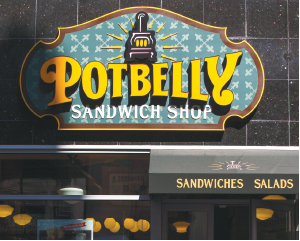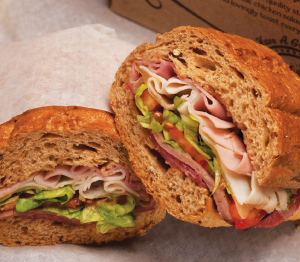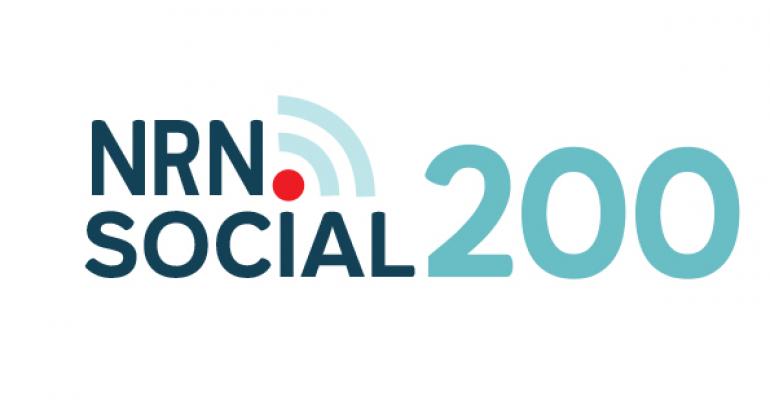 As the influence of social media continues to grow, restaurant companies are finding it has moved beyond a simple marketing tool to become the focal point of a company’s entire customer relationship management strategy. Some organizations currently outperform on this front.
As the influence of social media continues to grow, restaurant companies are finding it has moved beyond a simple marketing tool to become the focal point of a company’s entire customer relationship management strategy. Some organizations currently outperform on this front.
Whataburger, Potbelly Sandwich Shop and Legal Sea Foods are among the restaurant chains that have consistently excelled in incorporating social marketing strategy into their operations, according to the NRN Social 200.
The NRN Social 200, a real-time ranking of the social media activities of the nation’s largest restaurant chains, quantifies brand efforts and consumer engagement through data provided by social analytics firm Sprinklr.
At the end of the third quarter, the brands with the highest Engagement Ratio rankings tended to be smaller, regional groups. The Engagement Ratio figure measures all social activity, such as Tweets, likes, comments, shares and @mentions against a brand’s overall audience.
On that measure, San Antonio, Texas-based Whataburger ranked No. 1, followed by: Chicago-based Potbelly at No. 2; Dedham, Mass.-based Papa Gino’s at No. 3; Boston-based Legal Sea Foods at No. 4; and Bonefish Grill, owned by Tampa, Fla.-based Bloomin’ Brands Inc., at No. 5.
Whataburger finessed its way to the top spot in the engagement rankings by employing a social-media strategy that weighs existing fans with new customers.

San Antonio, Texas-based Whataburger has a total audience of 1.9 million across three major social-media platforms, including Facebook, Twitter and LinkedIn. The brand, which has restaurants in 10 states, has minimal presence on Google+ and YouTube.
Of that 1.9 million audience, the NRN Social 200 calculated that 11.5 percent, or more than 218,000 social media users, were actively involved with the brand in September.
“We have always placed an extremely high value on the relationships we have with our customers,” said Keith McLellan, social media manager for Whataburger. “We absolutely love serving them, and we appreciate their loyalty, so we listen to what they have to say [in social media as well as offline], and we do our best to provide them the Whataburger experience they have come to expect.” He said the burger chain regularly responds to customer questions and concerns through social media. It also provides content that highlights the brand and conveys information of interest to loyal customers.”
 “When Whataburger announced we were bottling our famous Fancy and Spicy Ketchup and making it available online, and at H-E-B Grocery, the response was overwhelmingly positive,” he said.
“When Whataburger announced we were bottling our famous Fancy and Spicy Ketchup and making it available online, and at H-E-B Grocery, the response was overwhelmingly positive,” he said.
McLellan indicated the company employs Facebook, Twitter and Instagram in its social efforts, with Twitter garnering the most engagement.
“We find both Facebook and Twitter, as well as Instagram, do an excellent job allowing us to really engage with our customers,” he said. “We see the highest engagement rate on Twitter, but we know that all of the platforms are valuable because they reach different audiences at different times.”
Thriving on 'word of mouth'

Potbelly Corp. extends its overall brand mission of making people “really happy” into its social-media strategy, according to Dan Yates, senior marketing director of the 312-unit, Chicago-based sandwich shop.
Yates credited that strategy with landing the No. 2 Engagement Ratio spot. The NRN Social 200 found that for the 30 days ended Sept. 30, 10.3 percent of Potbelly’s 93,300-fan audience, which is primarily found on Facebook, was actively engaged with the brand. Austin, Texas-based Sprinklr said that engagement, according to the Social 200 data, amplified Potbelly’s brand actions by 439.8 percent.
“Our brand has thrived because of our great customers and their passionate word of mouth,” Yates said. “They’ve been our advocates from the first shop in Chicago and fueled our growth. We view social media as our virtual neighborhoods, an extension to being the neighborhood sandwich shop.”

Since Facebook debuted in 2004, social-media platforms have increased in number and breadth to offer restaurant brands additional channels to connect and engage with their customers.
In the decade since Facebook’s founding, social media has expanded to include Twitter, Instagram, Google+, YouTube and more, and become an integral part of consumers’ lives.
But those conversations need to be interactive. The holy grail for many restaurant brands is finding ways to engage current and potential customers, and make existing patrons so happy that they will wax poetic about their experiences to their online connections. The playing field is fairly level in that regard, with smaller brands often exhibiting as much sway as the behemoths.
Ida Faber, vice president of marketing at the 35-unit Legal Sea Foods Restaurant Group, said the brand’s social media is handled in-house and devoted largely to Facebook.
Faber, who has been with Legal Sea Foods for seven years, said social media has become a more integral part of the company’s marketing mix in that time. “We try to communicate with our guests in a voice that is authentic to the brand,” Faber said. “And we try to provide fresh content.”
Toward that end, the company endeavors to post new content at least once a day and looks for appealing photos, she said.
“We are fortunate to have a brand that resonates with people over many generations,” Faber said. “They are passionate for the brand. It’s a virtual table, so to speak.”
Building great customer relationships
(Continued from page 2)
Legal Sea Foods generally posts photography, produced mostly in house, and by some outside providers, Faber said. “I see social media as an extension of other marketing. There should be an alignment so that you are communicating in the same voice and tonality as your other marketing activities.”
Such narrowly focused efforts as part of an overall marketing plan can be a wise choice for restaurant companies both big and small.
“For anything to do with restaurants, it’s important not to be so busy with looking at what’s next that we forget what we’ve got now can be used very well,” Faber said.
Some operators dedicate specific staffers to handle the immediacy that social media demands. For example, one reason Potbelly is able to focus its own social efforts is that it has a single, dedicated employee.
“We’ve had the Speaker of the House position [now held by Janet L. Nowlin] for almost 10 years,” Yates said.
 “Her job is focused 100 percent on engaging with our customers to ensure we are always doing the right thing for them. She talks to our customers on a daily basis whether it’s answering an incoming phone call, e-mail or Tweet. This role requires an articulate communicator who lives and breathes the brand and truly cares about our customers’ experiences,” Yates said.
“Her job is focused 100 percent on engaging with our customers to ensure we are always doing the right thing for them. She talks to our customers on a daily basis whether it’s answering an incoming phone call, e-mail or Tweet. This role requires an articulate communicator who lives and breathes the brand and truly cares about our customers’ experiences,” Yates said.
Yates said he believes that role is critical to building great customer relationships. “She can answer questions about when we’ll be opening a shop in their neighborhood or assist if we put the wrong cookie in their order. Answering and resolving issues consistently and with urgency, we believe, is a key part of our success and why we have such great loyal customers.”
Eimear Lambe, a brand strategist for Twitter in the United Kingdom, said the social platform calculates 72 percent of those who Tweet about a restaurant are leaving positive comments.
For those that don’t, 78 percent of those who leave negative comments are still in the restaurant when they do so, Lambe said. Those companies monitoring Twitter have the opportunity to address the problem in the moment, Lambe said, according to an article on William Reed Business Media’s BigHospitality website.
She said Twitter also found: 52 percent of platform users are more likely to visit a restaurant if some sort of discount or promotion is tweeted; 43 percent are attracted to pictures of a restaurant’s dishes; 39 percent are more likely to visit a restaurant if others have tweeted about getting great customer service, and 79 percent of users are influenced to patronize a restaurant if they see a tweet about the food being great or positive information about the menu.
Thinking less about expansion

At Legal Sea Foods, Faber said complaints are generally routed to the company’s customer-service department. “That department is very robust,” she said. “They do most of that fulfillment. When we see comments in social media, we try to steer them toward our guest-services department.”
The idea is sound, as long as that department has a way to handle social complaints quickly and close the loop. Scott Stratten, president of Unmarketing, a social media consultancy, and an author, said some restaurant brands are missing the boat when they overlook the consumer feedback available in social media channels.
“Restaurants trip over themselves trying to get you to fill out comment cards,” he said, adding that many quick-service restaurant receipts have grown to a foot long with information about how to participate in some reward deal for feedback.
Meanwhile, social channels are public, where other customers may read negative comments and chime in with their own. People also have review sites like Yelp and Urbanspoon at their fingertips on mobile phones with location-based recommendations.
“We have more information at our fingertips about a restaurant than ever before,” he said. “And nowadays nobody believes what restaurants say about themselves. They believe what customers say about the restaurant. Customers are more educated and have the resources. You don’t even know you are losing customers now. They don’t walk in and out anymore. They just don’t walk in at all.”
Thus, he suggested, operators should think less about expanding, for example, their Instagram empire and “make sure the restaurant is making customers happy with what they are getting now.”
If operators were to do one single thing tomorrow on the Internet, his suggestion is to set up a Google news alert “to hear everyday what’s happening online in regard to the restaurant or brand.”
“You can’t keep up with everything,” Stratten reiterated. “It’s not your job if you’re in the restaurant business to talk in social.” Efforts should be put toward quality of product and service, then consider getting the good word out.
Contact Ron Ruggless at [email protected].
Follow him on Twitter: @RonRuggless





